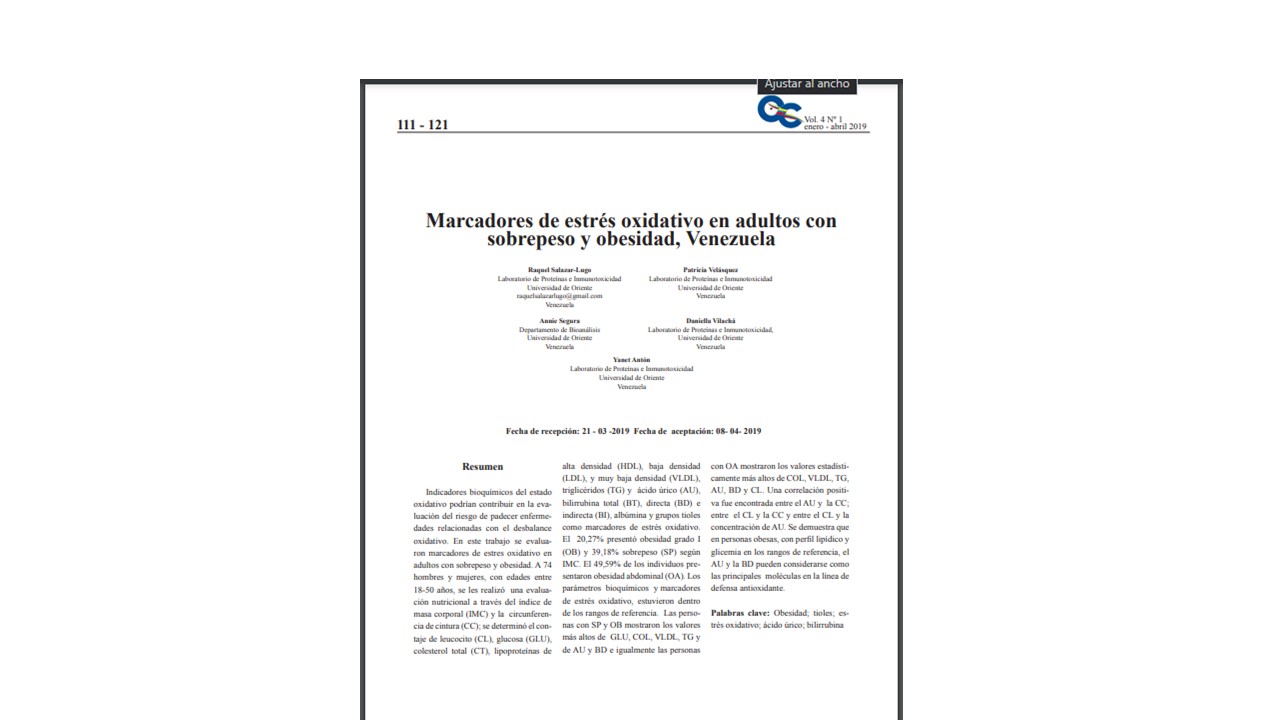Markers of oxidative stress in adults with overweight and obesity, Venezuela
Keywords:
Obesity, thiols, oxidative stress, uric acid, bilirubinAbstract
Biochemical indicators of the oxidative state could contribute in the evaluation of the risk of diseases related to oxidative imbalance. In this work, biomarkers of oxidative stress in overweight and obese adults were evaluated. 74 men and women, aged between 18-50 years, were evaluated through body mass index (BMI) and waist circumference (WC); We determined the count of leukocyte (CL), glucose (GLU), total cholesterol (TC), high density lipoprotein (HDL), low density (LDL), and very low density (VLDL), triglycerides (TG) and uric acid (UA), total bilirubin (TB), direct (DB) and indirect (IB), albumin and thiol groups as markers of oxidative stress. 20.27% presented obesity grade I (OB) and 39.18% overweight (OW) according to BMI. 49.59% of the individuals presented visceral obesity (OA). The biochemical parameters and markers of oxidative stress were within the reference ranges. People with OW and OB showed the highest values of GLU, COL, VLDL, TG and AU and DB and equally people with VO showed the statistically highest values of COL, VLDL, TG, AU, BD and CL. A positive correlation was found between the UA and the WC; between CL and WC and between CL and UA concentration. It is demonstrated that in obese people, with lipid profile and glycemia in the reference ranges, the UA and DB can be considered as the main molecules in the line of antioxidant defense.
Downloads
References
Borghi, C. Rodríguez-Artalejo, F. De Backer, G. Dallongeville, J. Medina, J. NUEVO, J. et al. (2018). Serum Uric Acid Levels are Associated with Cardiovascular Risk Score: A Post Hoc Analysis of the EURIKA Study. International Journal of Cardiology, 253,167-173.
Chen, W. Maghzal, G.J. Ayer, A. Suarna, C. Dunn, L.L. Stocker R. (2018). Absence of the BiliverdinReductase-a Gene is Associated with Increased Endogenous Oxidative Stress. Free Radical Biology Medicine, 115, 156-165.
De Mello, A. H. Costa, A. B. Engel, J. D. Grezin, G.T.(2018). Mitochondrial Dysfunction in Obesity.Life Science, 192, 26-32.
Ellman, G. (1959).Quantitative Determination of Peptides by Sulfhydryl (-SH) Groups.Archives of Biochemistry and Biophysics, 82, 70-77.
Engin, A.(2017). The Pathogenesis of Obesity-Associated Adipose Tissue Inflammation.Advances in Experimental Medical Biology, 960, 221-245.
Hermana, H. ; Hermsdorff, H. ; Puchau, B. ; Volp, A. Barbosa, B. ; Bressan, J. (2011). Dietary Total Antioxidant Capacity is Inversely Related to Central Adiposity as well as to Metabolic and Oxidative Stress Markers in Healthy Young Adults.Nutrition Metabolism (London), 8, 59.
Hotamisligil, G. (2006). Inflammation and Metabolic Disorders.Nature.444, 860-867.
Instituto Nacional de Nutrición (INN). (2013). Sobrepeso y obesidad en Venezuela (prevalencia y factores condicionantes). RepúblicaBolivariana de Venezuela.
Kurutas, E. B. (2016). The importance of antioxidants which play the role in cellular response against oxidative/nitrosative stress: current state. Nutrition Journal, 15(1), 71.
LI, W.C. MO, L.J. SHI, X. LIN, Z.Y. LI, Y.Y. YANG, Z. et al.(2018). Antioxidant Status of Serum Bilirubin, Uric Acid and Albumin in Pemphigus vulgaris.Clinical and Experimental Dermatology,43(2), 158-163.
LIU, Y. LI, M. SONG, Y. LIU, X. ZHAO, J. DENG, B. et al.(2018). Association of Serum Bilirubin with Renal Outcomes in Han Chinese Patients with Chronic Kidney Disease.ClinicaChimica Acta, 480, 9-16.
Ministerio del Poder Popular para la Ciencia y Tecnología e Industrias Intermedias (MPPCTI). (2011). Código de Ética para la Vida. República Bolivariana de Venezuela.
Niemann, B. ; Rohrbach, S. ; Miller, M.R.; Newby, D.E.; Fuster, V. ; Kovacic, J.C. (2017). Oxidative Stress and Cardiovascular Risk: Obesity, Diabetes, Smoking, and Pollution: Part 3 of a 3-Part Series., Journal of the American College of Cardiology, 70(2), 230-251.
Organización Mundial de la Salud (OMS). (1995). Uso e Interpretación de la Antropometría. Ginebra OMS-OPS.
Reho, J.J.; Rahmouni, K. (2017).Oxidative and Inflammatory Signals in Obesity-Associated Vascular Abnormalities.ClinicalScience (London). 131(14):1689-1700.
Rosas, J. ; Gonzalez, A.; Aschner, P. ; Bastarrachea, R. ; Sinai, I.; Costas A. et al. (2010). Epidemiología, diagnóstico, control, prevención y tratamiento del síndrome metabólico en adultos. Consensos Asociación Latinoamericana de Diabetes, 18(1), 25-44.
Salazar-Lugo, R.; Barahona, A.; Santamaría, M. ; Salas, H.; Oleas, M.; Bermeo, B. (2014). Marcadores de Estrés Oxidativo y su Relación con el Estado Nutricional en Adultos, Ecuador. ArchivosLatinoamericanos deNutrición, 64(4), 264-270.
Sedlak, L. (1968). Determination of Total Sulfhydryl Groups in Biological Samples using DNTB.Analytical Biochemistry, 25, 192-205.
Sokal, R.; Rohlf, J. (1980). Biometría, Principios y Métodos Estadísticos en la Investigación Biológica. Editorial Blum. Madrid. pp 120.
World Medical Association. (2013). World Medical Association Declaration of Helsinki: Ethical Principles for Medical Research Involving Human Subjects.Journal of the American Medical Association, 310(20), 2191-94.

Downloads
Published
How to Cite
Issue
Section
License

This work is licensed under a Creative Commons Attribution-NoDerivatives 4.0 International License.







